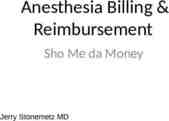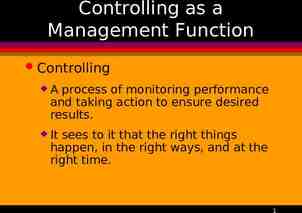Driving home after a 14-hour shift, Mr. Burns falls asleep at the
21 Slides64.51 KB
Driving home after a 14-hour shift, Mr. Burns falls asleep at the wheel and plows into Mel’s motorhome, causing extensive damage. As a result Mel and her family must move into a hotel until the repairs are completed. The cost of staying in a hotel is: An indirect loss A physical hazard A direct loss The proximate cause
Driving home after a 14-hour shift, Mr. Burns falls asleep at the wheel and plows into Mel’s motorhome, causing extensive damage. As a result Mel and her family must move into a hotel until the repairs are completed. The cost of staying in a hotel is: An indirect loss – added expenses or lost income because of physical damage A physical hazard - A physical condition that increase the chance of a loss A direct loss – Direct Loss means physical harm to tangible property caused by a peril. The proximate cause – when there is an unbroken chain of events between an occurrence and a loss, then that occurrence is the proximate cause of the loss
Driving home after a 14-hour shift, Mr. Burns falls asleep at the wheel and plows into Mel’s motorhome, causing extensive damage. As a result Mel and her family must move into a hotel until the repairs are completed. The cost of staying in a hotel is: An indirect loss A physical hazard A direct loss The proximate cause
An “occurrence” is defined as: Something that increase the chance of a loss An unexpected event that causes loss An insured item The likelihood of experiencing a loss
An Occurrence is an event, incident, or condition that causes damage. Example – gutters damaged due to ice dam For example, a lightning bolt striking a house is an Occurrence, as is a fire in the kitchen, hail denting a car, or a vandal breaking a window. These are all unexpected events that cause damage.
An “occurrence” is defined as: Something that increase the chance of a loss An unexpected event that causes loss An insured item The likelihood of experiencing a loss
During a storm, lighting strikes a tree in Harry’s yard and starts a fire that spreads to his shed where he keeps all his equipment for his landscaping business. In addition to the shed, Harry has to purchase all new equipment to stay in business. The cost to replace the equipment would be considered: A peril An occurrence A direct loss An indirect loss
During a storm, lighting strikes a tree in Harry’s yard and starts a fire that spreads to his shed where he keeps all his equipment for his landscaping business. In addition to the shed, Harry has to purchase all new equipment to stay in business. The cost to replace the equipment would be considered: Direct vs indirect loss: Direct loss: physical damage Indirect loss: added expenses of lost income because of physical damage An Occurrence is an event, incident, or condition that causes damage. A peril is anything that causes actual damage. Lightning, hail, fire, vandals, hurricanes are all examples of perils.
During a storm, lighting strikes a tree in Harry’s yard and starts a fire that spreads to his shed where he keeps all his equipment for his landscaping business. In addition to the shed, Harry has to purchase all new equipment to stay in business. The cost to replace the equipment would be considered: A peril An occurrence A direct loss An indirect loss
When record-breaking rainfall causes severe flooding in Janie’s home town, Janie’s rental property suffers extensive damage. Which of the following is an indirect loss? Janie must pay to have the wood floors replaced in her rental unit Janie loses a month of rental income when her tenant must move out while repairs are made to the home Janie must hire a contractor to reinforce a damaged retaining wall in the backyard of her rental unit Janie’s tenant has to replace his sofa that was damaged by the way.
Indirect Loss Indirect Loss is an economic loss that results from the direct, or physical, loss. Example - car crashing into a house. As a result of the structural damage to the home, as well as the fire and water damage, the residents would have to rent a hotel room while their home is being repaired. The hotel bill is an Indirect Loss, an economic consequence of the direct losses to the house.
When record-breaking rainfall causes severe flooding in Janie’s home town, Janie’s rental property suffers extensive damage. Which of the following is an indirect loss? Janie must pay to have the wood floors replaced in her rental unit Janie loses a month of rental income when her tenant must move out while repairs are made to the home Janie must hire a contractor to reinforce a damaged retaining wall in the backyard of her rental unit Janie’s tenant has to replace his sofa that was damaged by the way.
Driving home after a 14-hour shift, Mr. Burns falls asleep at the wheel and plows into Mel’s motorhome, causing extensive damage. As a result Mel and her family must move into a hotel until the repairs are completed. Mr. Burns’ car crashing into the house would be considered: An out-of-pocket expense An occurrence An indirect loss A physical hazard
Driving home after a 14-hour shift, Mr. Burns falls asleep at the wheel and plows into Mel’s motorhome, causing extensive damage. As a result Mel and her family must move into a hotel until the repairs are completed. Mr. Burns’ car crashing into the house would be considered: An out-of-pocket expense An occurrence An occurrence is simply an event or circumstance that causes loss. A physical hazard Physical hazards are physical conditions that increase the chance of loss. An indirect loss If a fire destroys a bakery’s fleet of delivery trucks: The physical destruction of the trucks is a direct loss The cost of renting new trucks in order to keep business going is an indirect loss
Driving home after a 14-hour shift, Mr. Burns falls asleep at the wheel and plows into Mel’s motorhome, causing extensive damage. As a result Mel and her family must move into a hotel until the repairs are completed. Mr. Burns’ car crashing into the house would be considered: An out-of-pocket expense An occurrence An indirect loss A physical hazard
A power surge sparks a small electrical fire in an office building. The electrical fire triggers the automatic sprinkler system. The water from the sprinklers soak the carpets and short-out all the computers, causing thousands of dollars in damage. What is the proximate cause of the loss? The power surge The electrical fire The automatic sprinkler system The water from the sprinklers
Proximate Cause of Loss Proximate cause is a key principle of insurance and is concerned with how the loss or damage actually occurred and whether it is indeed as a result of an insured peril. The original occurrence: Causes damage that then leads to more damage. Is the proximate cause of all resulting losses Example - let’s say a car crashes into a house and catches fire. When the fire department puts out the car fire, the water causes thousands of dollars of water damage to the flooring. The car crashing into the house is the Proximate Cause of all the resulting damage: the hole in the wall, the fire damage, the smoke damage, and the water damage.
A power surge sparks a small electrical fire in an office building. The electrical fire triggers the automatic sprinkler system. The water from the sprinklers soak the carpets and short-out all the computers, causing thousands of dollars in damage. What is the proximate cause of the loss? The power surge The electrical fire The automatic sprinkler system The water from the sprinklers
Jane’s Shed burns to the ground during a tornado, when the high winds break a wall of the shed, knocking over a lantern inside. What is the proximate cause of the loss? Wall collapse The lantern Wind Fire
Proximate Cause the doctrine of proximate cause is very important in the insurance industry. If an insurer guarantees protection from damages resulting from a specific peril, then the insurer must compensate the policyholder for all the damages related to the unbroken chain of events that began with the covered peril. The damage must directly result from the proximate cause. If wind blows off part of a roof and rain pours through the hole, causing damage to drywall and flooring, all losses would likely be covered. If during the repairs it is found that the chimney is cracked and in need of repair, that would not be covered without proof that the crack was a result - direct result - of the very same windstorm.
Jane’s Shed burns to the ground during a tornado, when the high winds break a wall of the shed, knocking over a lantern inside. What is the proximate cause of the loss? Wall collapse The lantern Wind Fire


























